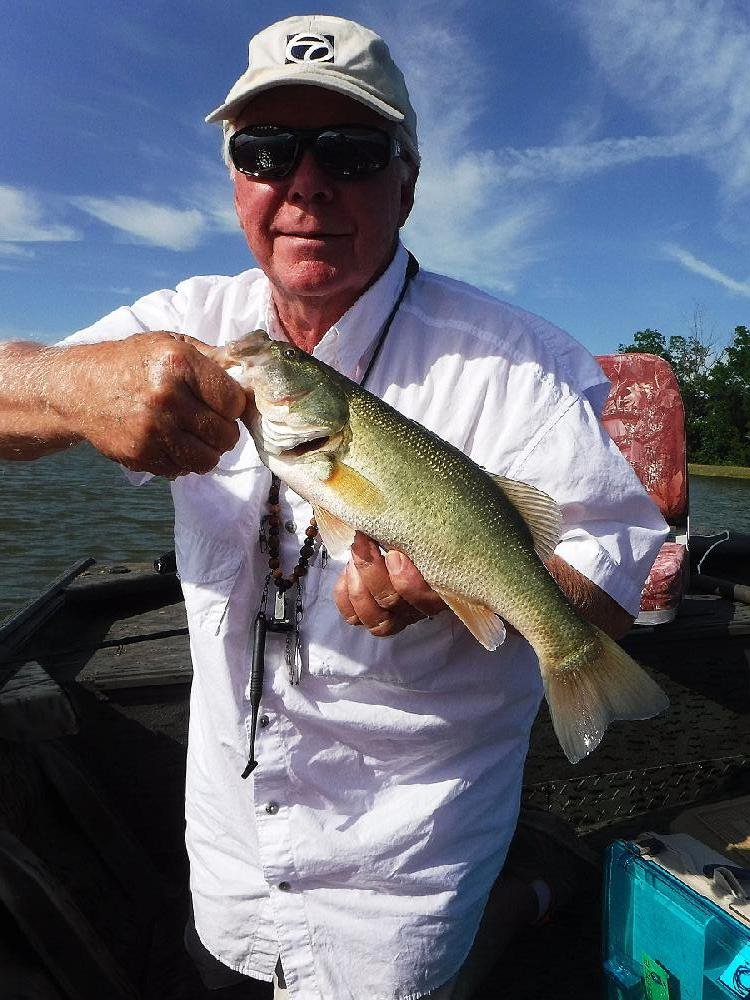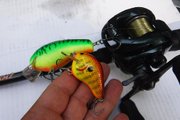SHERRILL -- I love catching bass with crankbaits.
I love the way a crankbait arcs through the air in flight, and I love the way it vanishes like a submarine when I engage the reel.
I love the way it throbs through the rod when it moves, and I love the way it feels when it bounces off rocks and brush.
More than anything, I love the jolt through the wrists when a bass slams a crankbait. It's not a subtle thump like when a bass inhales a plastic worm or lizard. When a bass hits into a crankbait, it means to kill it.
You don't set the hook in the traditional way, with a hard jam to drive a single hook through lure plastic and then through a fish's mouth. It's a slow sweeping motion through the hips mainly designed to pull the slack from the line. Once the line is taut, the fish hooks itself, and then the fight is on.
I enjoyed my best crankbait outing in ages Thursday when Ray Tucker, host of Ray Tucker's Arkansas Outdoors, It's a Natural radio program (Wednesdays from 7-9 p.m., on KMJX, 103.7-FM) called to say that a friend, Wes McNulty of Sherrill, invited us to fish his private reservoir.
It's an 80-acre irrigation reservoir. Tucker and I had never seen it, so we didn't know what to expect. My image of irrigation reservoirs includes lots of standing timber, buckbrush, shallow water grass and maybe lily pads. I packed enough gear to fish all of those things.
"Did you clean out your garage?" Tucker asked when he saw my seven rods and tackle arsenal.
"You never want to get to a place and say, 'Dang, I wish I'd brought this, or I wish I'd brought that,'" I replied. "So I brought it all."
The lake's appearance was surprising. It was a rectangle, with an unobstructed view from one end to the other. There are no stumps and no snags. The only visible cover is a short, single strand of flooded trees in the middle. The banks are open, clear and manicured.
There are, however, three stakes near one end that stretch nearly from one side to the other. McNulty put them there for our benefit.
"There's an old levy that runs across that has cuts in it," he said. "I put those stakes out there so you'll know where it is. It drops down to about seven feet off the sides, and that's where we catch most of our bigger fish."
McNulty also provided us a boat, a War Eagle 648 with a 40-horsepower Evinrude outboard and a 55 pound-thrust Minn-Kota trolling motor. He was especially proud of the outboard, a 4-stroke model with a long tiller, complete with integral tilt and trim. No water is too shallow for it.
McNulty showed us some of his most productive lures, including a citrus-colored shad, tandem-blade spinnerbait and various soft plastics in shades of watermelon and pumpkin.
The day was cool and bright, with a slight northeast breeze that rippled the water. We started fishing immediately, but with no visible cover to fish, we were in a fact-finding mode. I tied on a Bagley Balsa B1 squarebill crankbait in chartreuse crayfish color. It dives to a maximum depth of about 3 feet, and like all squarebills, it is practically snagproof. It's perfect to cover water quickly and find hidden cover below the surface.
A bass smacked the third cast near the bank, and the action did not let up until sundown.
Several strikes came almost as soon as the lure hit the water, but most came about 15-20 yards away from the bank. I didn't know where most of the bass actually were, or if they struck after following the lure away from the bank.
At the same time, the lake's surface was aboil from bass smashing live shad. Through my polarized, high-definition bronze shades, I saw great clouds of tiny baitfish drifting like oil slicks through the water. Occasionally they came to the surface on their own, but usually they surfaced amid a flurry of splashing, thrashing largemouth bass.
The schooling activity was almost like fishing for speckled sea trout in the Gulf of Mexico. Expanses of "nervous" water formed all around us as bass forced baitfish to the surface, followed by a thunderous splash.
"I think the bigger fish are out chasing this bait," I said to Tucker, who was growing impatient with a lack of bites from the back of the boat. "Tie on a jerkbait and see what's out on the deep side."
Tucker tied on a Luck-E-Strike Rick Clunn stickbait with a purplish hue. The results were immediate. He caught bass after bass, but they were the same size -- up to about 2 pounds -- as the crankbait fish.
Convinced bigger fish were in those schools, we trolled slowly down the lake, looking for nervous water and casting at every splash and boil. Tucker continued catching fish, but they ignored my stickbait, which was a larger version of the one Tucker used.
Finally we reached the stake line that marked the submerged levee. As McNulty described, bass were stacked along the sides, and they mauled the Bagley crankbait at every angle and every presentation.
Disappointment struck when I bounced the crankbait off the top of the levee and tore off the lip. Bagley baits are too expensive to be built so poorly, but that was the only blot on an otherwise perfect day.
We started fishing at about 4 p.m. and quit at dark. During that time, Tucker and I caught and released about 50 bass.
It's hard to find a bit of fault in a day like that, but I was most pleased to have made a new friend.
Sports on 06/11/2017


